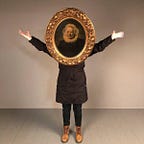How To Cook Porpoises: Artists In The Kitchen
The connection between art and food has been a topic that has inspired critics and scholars for decades. Still life artworks are often homages to anything from eggs to broccoli heads and food has featured in art in some pretty radical ways… I’m looking at you, Giuseppe Arcimboldo’s crazy Renaissance heads, dedicated to the four seasons and four elements.
You’ll even see current television shows treating food and cooking in an artistic way, with long panning shots of beautifully presented bowls of deconstructed lasagne — look no further than the cult Netflix hit The Chef’s Table. The chefs become akin to artists — creating expressive food that treats the senses — especially taste (derr, pretty obvious I know) and sight. Instagram has allowed us to visually present our food in an entirely artistic way. It’s fair to say that Instagram food bloggers consciously focus on composition, colours, tone and brightness. This causes freshly made food to go cold as we try and pose a slice of pizza awkwardly against our marble counter tops, capturing our dinner as quickly as possible. Sometimes, artists even deliberately stray into the kitchen — creating some of the most visual and dare I say it, fun, crossovers between art and food.
Nearly 3 years ago, I stumbled upon the cookbook The Art of Cuisine by Henri de Toulouse Lautrec, published in 1966 by his art dealer Maurice Joyant. Impressed with my find, I immediately bought it as a joke present for my father: an artist, former puppeteer, ‘belonging to a different time’ kind of man and extraordinary cook. Once I started reading it (after I gave him the present, I’m not a monster), you begin to see a delightful insight into the personal life of arguably one of the most interesting French artists of the late 1800s. His ingredients were sourced from his own ‘hunting’ methods, like using a cormorant to catch fish in Normandy, or foods that were sent to him from his family in rural France. His recipes include stewed fillets of porpoise, for those able to catch them. Other recipes feature young pigeons, quails and marmots cooked in inventive, different ways — all assured to excite your dinner guests. The recipes are presented in a ‘menu’ like format, and accompanying them are illustrations and whimsical sketches of ingredients and the like. The book shows his delight in cooking, and his feasts and eccentric table manner were notorious in Parisian society of the time.
For a more surreal cooking experience, look no further than Salvador Dalí’s cookbook — a testimony to his love for food and the pursuit of gastronomy. In Les Diners de Gala (published 1973) Dalí and his wife Gala show us their recipes including Crayfish Consomme and Thousand Year Old Eggs. Their full-colour illustrations and drawings are even more bizarre than Chef Lautrec. The ingredients and plated up recipes are photographed and presented as if in worship — sumptuously piled high to the sky, croquembouche-style crayfish with their orange colours contrasting the silver serving dishes. Unlike Toulouse Lautrec, Dalí featured food in his art, and so his cookbook is almost like a continuation of his works, including The Basket of Bread 1926 (a remarkable realist still life painting) and Lobster Telephone, 1936. The cookbook is infused with surrealist touches, in one instance Dalí’s illustrations of skewered birds morphing into Judgement of Hell-like paintings are placed alongside ‘serious’ recipes like Toffee With Pine Cones. Once considered a priceless collectable, the book was re-released in 2016 by Taschen so that we too can enjoy in delights such as the erotic chapter dedicated to aphrodisiacs.
Family members of artists including Claude Monet and Frida Kahlo have also produced cookbooks based upon their love of food and mastery in the kitchen. Monet’s Table published in 1990, and authored by Claire Joyes (the wife of his great grandson) is a collection of recipes placed alongside Monet’s paintings, pictures of his house and garden in Giverny. The book gives a romantic vision of Monet’s kitchen and home as a place where his friends and family would meet, promptly at 11:30am for lunch. He never had dinner guests — my kind of man, I like an early bedtime too.
Guadalupe Rivera (stepdaughter of Frida Kahlo) and author Marie-Pierre Colle published Frida’s Fiestas: Recipes and Reminiscences of Life with Frida Kahlo as a testament to Kahlo’s love of cooking. The cookbook is structured so that it follows the cycle of festivals when Kahlo would have cooked the recipes. It seems to be in a similar vein to Monet’s Table — providing a personal portrait of the home and the kitchen of the artist, without necessarily being too ‘art heavy’. In more recent times we’ve also seen publications uncovering the cooking identities of artists ranging from Jackson Pollock to Georgia O’Keefe.
As our obsession with baking and trendy cooking shows grows out of control like the plant in Little Shop Of Horrors, we’re also seeing cookbooks producing recipes inspired by art. Modern Art Cookbook and Modern Art Desserts were both serious bestsellers. Don’t worry, these trends aren’t being missed by art galleries and museums. Modern Art Desserts originated in San Francisco Museum of Modern Art as a way to continue the experience of the gallery into the cafe, delighting the tastebuds and eyes of visitors. National Galleries Scotland even endeavoured to create a cocktail based on the legendary dinner/cocktail parties of Lee Miller (you can read more about this in their blog here). These crossovers show our increasing desire to consider artworks and artists in more innovative and tasty ways — and in the instance of artist’s cookbooks, discover more about their personal lives, habits and tastes.
So as our desire for lush, glossy photographed cookbooks grow, there’s no doubt we’ll see more collaborations between artists (or their relatives) and publishers. I personally can’t wait to see Cooking with Rubens: I Had Nothing To Do With The Sandwich.
